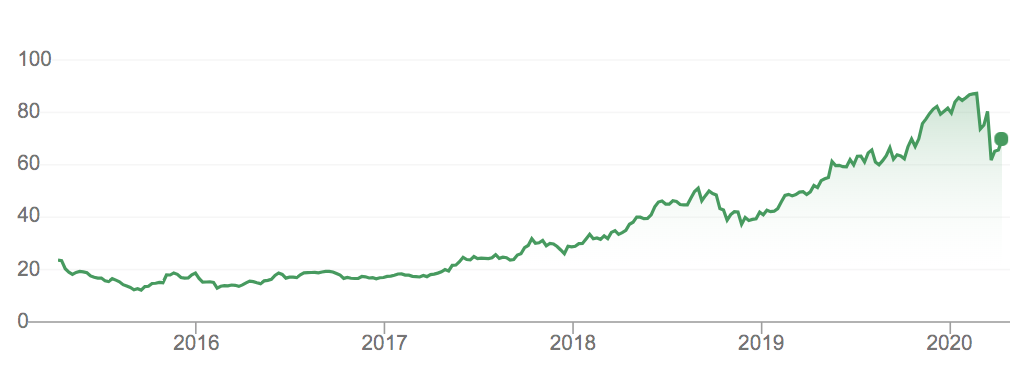I know it’s not very professional — nor profitable — to fall in the love with a company, even if the performance of the Xero Limited (ASX: XRO) share price still manages to bring a tear to this shareholder’s eye…
XRO share price – 5 years

The thing is, I can’t claim to have experienced all of the upside in Xero shares since 2016. I originally bought shares around $17, then sold at a price not much higher about a year to 18 months later… only to watch it rocket higher. However, I did manage to buy back into Xero — and recommend it to Rask Invest members in August 2018 — at a share price of $44.73.
Here are five reasons we’re still holding Xero shares, and why you might consider at least watching it over the next two years as COVID-19 causes more volatility and weaker small business numbers cloud the brighter long-term outlook for the company.
1. Its economics are oh-so-delicious
I created the Rask Education video above as part of my Value Investor Program. It uses Afterpay Ltd (ASX: APT) as the case study for demonstrating how some technology analysts understand and interpret the scalability and economics of online subscription businesses (SaaS).
For years, investors have bitterly underestimated Xero’s ability to generate returns because “it’s not profitable.” Those same analysts would probably have questioned how a company like Amazon.com (NASDAQ: AMZN) — now valued around $1 trillion — was investment grade.
However, the basic idea for any business is that it costs less to acquire a new customer (customer acquisition cost or CAC) than they pay over their expected lifetime (customer lifetime value or LTV for short).
In 2019, Xero had an LTV-to-CAC ratio of 6x. Meaning Xero estimates it gets $6 back for every $1 it spends to get that customer paying for its product. I suspect this number will skew against Xero in the year ahead as many small businesses grind to a halt and overall subscriber growth slows. That said, this ratio doesn’t account for more products being sold via add on features or acquisitions.
2. It might be stormy overhead but the Cloud is a BIG thing — and it’s here to stay
Walk into any decent accounting office and you should see fewer and fewer boxes of client files and documents. Why? It’s all moving to the Cloud.
Xero is the most sophisticated software for accountants to use because it was built in a cloud-first environment. While all of the competing products, including QuickBooks, Intuit (NASDAQ: INTU), Sage, MYOB and Reckon now offer a cloud-based alternative, they weren’t born this way.
Being cloud first means Xero can scale incredibly well because an additional customer doesn’t require a CD or even so much as a download to start using and paying for its software. Just visit Xero.com, create an account and log in!
The incremental revenue from each new customer is all margin for Xero. What’s more, the company has been iterating its product for years, including adding to its machine-learning and artificial intelligence (AI) customer service engine called Xero Central.
The Cloud is here to stay. It’s transforming businesses and households around the world. Xero is very well placed to serve a remote and centralised workforce catering to small businesses.
3. Balance sheet strength
The only meaningful piece of debt that Xero had on 30 September 2019 was its convertible notes. According to its period report, the company had $395 million of debt. This was matched with $385 million of short-term deposits and $111 million of cash in the bank.
At the gross profit margin, which is where most investors can begin to understand the scale and profit potential of a tech company, Xero generated $288.5 million of profit. From this, $230 million was plowed back into marketing and research & development — costs that are within the company’s control.
4. It’s sold by technicians to people who (typically) do not give a rats about accounting
One of the great things about businesses like Bapcor Ltd (ASX: BAP) and Nordstrom Inc (NYSE: JWN) is their deep integration into their client’s lives and the fact that products require technical knowledge.
For example, if you decide to get your car fixed at a mechanic and the mechanic says “it’s $300 for parts and $400 for labour” you often don’t flinch at the cost of parts (supplied by Bapcor). After all, the parts are required to fix your car. In addition, you likely don’t understand cars well enough to disagree on prices, you need it back on the road to go to work and there’s probably a part of you which just assumes the mechanic is looking out for you. These are great factors working in Bapcor’s favour to keep you paying.
When it comes to accounting, the value proposition for small businesses using Xero is that their technical professional (accountant) says, “paying $75 per month for Xero means you will save three hours of my time — I cost $350 per hour.”
Most people don’t understand accounting but they know it’s a bill they must pay because it’s essential to stay compliant with the law. And for accountants, using software like Xero is crucial to remaining competitive and engaging with more clients.
In my opinion, the low costs and technician-to-consumer relationship mean a Xero subscription is one of the last costs to go before the business closes up shop. Even a struggling business needs accounting.
5. Short term pain, long-term gain
Xero served over 2 million customers/subscribers in 2019 with an incredible 478,000 new subscribers added in just one year.
While the company was in a rapid-growth phase, it won’t be immune to the COVID-19 induced small business shut-down. It’s too early for me to quote the latest economic numbers and accurately forecast the impact on Xero next year (note: the company reports soon).
That said, it’s a near certainty the business will be hit in the USA and UK. These markets accounted for 215,000 and 536,000 subscribers, respectively.
The counterpoint is that the economic slow-down and move to remote working will increase uptake by some businesses and accountants who delayed migrating to the Cloud. Many of them will be forced to go paperless during the COVID-19 slowdown.
In addition to the Cloud migration pushing new subscribers onto the platform, Xero has quite a few levers it can pull with regards to costs if it needs to.
All-in-all, in my mind it’s a matter of when — not if — small business bounces back with a vengeance and Xero begins to take more share of the accounting pie in Australia, New Zealand, UK and other parts of the world.
Buy, Hold, Sell
Even as a long-term investor (5-10+ years) I’m not oblivious to the short-term pain that Xero will likely experience as small businesses throughout the world go out of business completely, forgo their subscriptions to save every penny or try to find the cheapest alternatives.
Seeing past the next 12-24 months however, I think it’s likely Xero will emerge as a stronger, leaner and more profitable business. It is one of the best accounting products on the market. It saves time and money, and it works beautifully with accountants who service small businesses.
Maybe I am falling in love?
To get the name of more cloud stocks I’m keen to own in 2020 (or do already), grab a copy of our investment report below.
[ls_content_block id=”18457″ para=”paragraphs”]
Disclosure: at the time of publishing, Owen owns shares of Xero.



